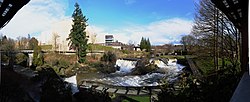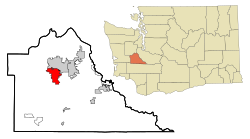Tumwater, Washington
Tumwater, Washington | |
|---|---|
 Panoramic view of the upper falls & the former Olympia Brewery, 2011 | |
| Nickname: Washington's First Community | |
 Location of Tumwater, Washington | |
| Country | United States |
| State | Washington |
| County | Thurston |
| Incorporated (town) | November 25, 1869[1] |
| Government | |
| • Type | Mayor-council government |
| • Mayor | Peter N. Kmet |
| Area | |
| • Total | 14.49 sq mi (37.5 km2) |
| • Land | 14.32 sq mi (37.1 km2) |
| • Water | 0.1 sq mi (0.4 km2) |
| Elevation | 174 ft (53 m) |
| Population (2010) | |
| • Total | 17,371 |
| • Density | 1,212.9/sq mi (468.3/km2) |
| Time zone | UTC-8 (Pacific (PST)) |
| • Summer (DST) | UTC-7 (PDT) |
| ZIP codes | 98501, 98511, 98512 |
| Area code | 360 |
| FIPS code | 53-72905Template:GR |
| GNIS feature ID | 1512742Template:GR |
| Website | http://www.ci.tumwater.wa.us/ |

Tumwater is a city in Thurston County, Washington, United States. It lies near where the Deschutes River enters Budd Inlet, the southernmost point of Puget Sound. The population was 17,371 at the 2010 census. Thurston County, which includes the cities of Lacey, Olympia and Tumwater, has a population of 252,264.
History
Tumwater was founded next to the falls of the Deschutes River at the south end of Puget Sound as New Market in 1846 by a group of pioneers led by Michael Simmons and George Bush. It was the first American settlement on Puget Sound. These early settlers were attracted by the water-power potential from the falls, the easy access to Budd Inlet for shipping, and the open prairie land in the area for cattle grazing.
A major factor driving the Simmons-Bush Party to locate north of the Columbia River beyond Oregon Territory is that the American settlers in Oregon prohibited settlement by non-whites to avoid the contentious slavery issue. Bush, a mulatto, was not allowed to own land under Oregon law. Later, when the area north of the Columbia became part of US territory, white settlers petitioned Congress to grant Bush title to his land, which was approved.
The name was changed to Tumwater borrowing from a Chinook Jargon phrase tumtum chuck meaning "waterfall" or "rapids" (literally "heartbeat water"). Despite its early settlement date, Tumwater wasn't officially incorporated until November 12, 1875.
For many years Tumwater was well known regionally as the home of the Olympia Brewing Company. The company began producing beer in 1896 at a site along the Deschutes River and continued until Prohibition. After Prohibition ended, a new brewery was erected just upstream from the original site. This brewery was eventually purchased by SABMiller and closed on July 1, 2003.
Geography
Tumwater is located at 47°0′28″N 122°54′40″W / 47.00778°N 122.91111°W (47.007768, -122.911074).Template:GR The city that borders Tumwater is Olympia.
According to the United States Census Bureau, the city has a total area of 10.1 square miles (26.1 km²), of which, 9.9 square miles (25.8 km²) of it is land and 0.1 square miles (0.3 km²) of it (1.29%) is water.
Demographics
Based on per capita income, one of the more reliable measures of affluence, Tumwater ranks 89th of 522 areas in the state of Washington to be ranked. It is also the highest rank in Thurston County.
| Census | Pop. | Note | %± |
|---|---|---|---|
| 1890 | 410 | — | |
| 1900 | 270 | −34.1% | |
| 1910 | 490 | 81.5% | |
| 1920 | 472 | −3.7% | |
| 1930 | 793 | 68.0% | |
| 1940 | 955 | 20.4% | |
| 1950 | 2,725 | 185.3% | |
| 1960 | 3,885 | 42.6% | |
| 1970 | 5,373 | 38.3% | |
| 1980 | 6,705 | 24.8% | |
| 1990 | 9,976 | 48.8% | |
| 2000 | 12,698 | 27.3% | |
| 2010 | 17,371 | 36.8% |
As of the censusTemplate:GR of 2000, there were 12,698 people, 5,659 households, and 3,253 families residing in the city. The population density was 1,276.1 people per square mile (492.7/km²). There were 5,953 housing units at an average density of 598.2 per square mile (231.0/km²). The racial makeup of the city was 88.41% White, 1.39% African American, 1.24% Native American, 3.90% Asian, 0.36% Pacific Islander, 1.50% from other races, and 3.21% from two or more races. Hispanic or Latino of any race were 4.08% of the population.
There were 5,659 households out of which 28.3% had children under the age of 18 living with them, 41.5% were married couples living together, 12.3% had a female householder with no husband present, and 42.5% were non-families. 33.7% of all households were made up of individuals and 10.2% had someone living alone who was 65 years of age or older. The average household size was 2.20 and the average family size was 2.82.
In the city the age distribution of the population shows 23.2% under the age of 18, 10.9% from 18 to 24, 29.5% from 25 to 44, 23.0% from 45 to 64, and 13.5% who were 65 years of age or older. The median age was 36 years. For every 100 females there were 89.8 males. For every 100 females age 18 and over, there were 84.5 males.
The median income for a household in the city was $43,329, and the median income for a family was $54,156. Males had a median income of $41,778 versus $32,044 for females. The per capita income for the city was $25,080. About 4.3% of families and 8.5% of the population were below the poverty line, including 9.5% of those under age 18 and 5.2% of those age 65 or over.
Government
The Washington State Department of Corrections has its headquarters in Tumwater.[2]
Education
The Tumwater School District is home to Tumwater High School, A. G. West Black Hills High School, Black Lake Elementary School, East Olympia Elementary School, George Washington Bush Middle School, Littlerock Elementary School, Michael T. Simmons Elementary School, New Market Skills Center, Peter G Schmidt Elementary School,Tumwater Hill Elementary School, and Tumwater Middle School.[3]
References
- ^ "Tumwater History". Retrieved 2009-05-26.
- ^ "Contact Us." Washington State Department of Corrections. Retrieved on December 7, 2009.
- ^ "Tumwater School District". Retrieved 2009-05-23.
External links
- City of Tumwater, Washington (official website)
- Michael T Simmons at Findagave
- George Bush at Findagrave

